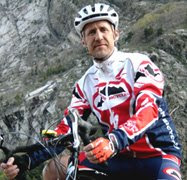 On my long list of bikes I've owned (look to the right side of this blog in case you haven't noticed) there is only one Kawasaki. It's no reflection on the brand, they are good bikes. I flirted with getting a KX125 back in 1978 when I was shopping around that year. The 1978 bike was very fast. It had a case-induction motor that used a side-mounted impeller to induct gas directly into the bottom end and made some great low-end power (for a 125).
On my long list of bikes I've owned (look to the right side of this blog in case you haven't noticed) there is only one Kawasaki. It's no reflection on the brand, they are good bikes. I flirted with getting a KX125 back in 1978 when I was shopping around that year. The 1978 bike was very fast. It had a case-induction motor that used a side-mounted impeller to induct gas directly into the bottom end and made some great low-end power (for a 125).Most of the 125 we were used to riding and racing were woefully deficient of any low-end power. The Hondas we had grown up racing had a sort of insistent, albeit weak, winding powerband that started off with literally nothing on bottom (the clutch was the prime motivator if you ever fell off the power), a noticable rush of power in the midrange and steadily ascending into what amounted to a shreik at the very top.
The Kawasakis were known for making good power at the lower reaches of the powerband. This style of power paid off for the brand for a few great years, and by 1984 or so they were competitive, if not dominant, players in 125 racing.
This particular 1986 Kawasaki entered my life during a long, non-current, and financially broke period of my young adult life. I believe at the time the only motorcycle I owned was my old 1978 Maico which was hopelessly outdated and, frankly, embarassing to be seen on. I had no money for more current iron, but I did have a desire—and was also ambitious and clever, having developed some keen motorcycle-acquiring skills that were honed over the years of dreaming from one bike to the next.
I was able to work out a trade for some design work with a man named John Maughan who's son Corky was the number 1 pro in 1986. I think this bike was given to Corky from some kind of shop sponsorship and since he was now on something newer and certainly better, this unloved, slightly dog-eared, and wrung-out machine was, at least to John, expendable. John owned the local motocross paper, Utah Cycle News, at the time and was looking to upgrade the look. I was looking to upgrade my mode of recreation, so a deal was struck.
Corky was a fast rider and had won the number 1 plate against the best Utah (and regional) competition at the time. The bike, as mentioned, was well-used but must have been well broken in because it seemed that all the parts, while loose and slapping against each other, all moved in an easy, slick and free revving manner. It was as if the moving parts all wore out at the same rate, creating a harmony of function that made a lot of noise but got that green bike moving in a hurry.
One thing that certainly contributed to the speed of the motor was the fact that John was a big engine tuner, and the cylinder on that bike contained some amazing boost ports that were cut into the cases at the induction. As I recall, the cylinder was ported to the extent that there was as much hole as cylinder wall, normally a recipe for disaster. I think the basic engine design was reliable, and also the Maughan's were sponsored by a shop, so replacement parts were plentiful, and since Corky was racing every weekend they had plenty of opportunity to break and replace parts. But nonetheless, this bike was well wrung out by the time I got it. In fact, every part moved in ways not originally intended.
I got many hours of riding this bike at tracks like "56" (shown) and one thing I remember was how insanely fast it was and that it handled very well if you knew how to ride it. The Kawasakis from 1986 were very advanced bikes at the time. The 1985 bike was a "factory works" replica that came to the public in a very advanced design, and the 1986 bikes had built on that design. I think the handling and steering were a little unorthodox, at lease as compared to the other 125s at that time. The Hondas and Suzukis had very quick steering and were a little busy at speed as a consequence. The Yamahas had always been "rear end" handlers that you would slide through the corners. The Kawasaki had a slightly "unhinged" feel to it in the corners with the bike able to turn a fairly tight line, but also posessed good stability on the fast sections. It was a little unusual to get used to, but actually worked very well once you forgot about it.

